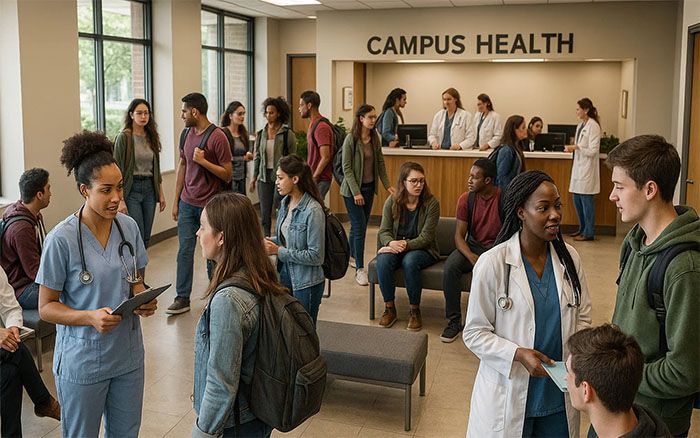Connecting Students with Key Resources
Many college students struggle to find the support they need. While the stigma around seeking help is lessening, navigating a maze of resources can be overwhelming. This strains college health and counseling centers, which are often tasked with connecting students to resources available on and off campus.
This blog summarizes the highlights from our most recent webinar featuring Erin Halligan-Avery, CEO of ConcernCenter, and Darlene Schmitt, Associate Director of Counseling at SUNY Brockport.
We dive into how schools can leverage a centralized resource directory (like ConcernCenter) to more seamlessly connect staff, students, faculty, and administrators with vetted resources to support student well-being.
Q. Do you provide information about off-campus resources?
Darlene: Our school does both. We focus on-campus resources and promote some vetted community options for specific needs. We’re expanding community resources in an upcoming summer update.
Erin: I’ve seen schools offer a mix of campus and nearby community resources. Virtual resources are also increasing in popularity for broader support such as apps and videos.
Q. Darlene, can you share an example of a resource that your campus has available on your resource directory?
A: Of course. One resource we offer is a Student Mental Health Fund which grants up to $1,000 for mental health-related financial needs. Students may come across this resource when they enter “money” into our platform. This is a resource that not many students (and even staff and faculty) know about and probably wouldn’t have otherwise found unless they utilized our resource platform.
Q: Darlene, where does your campus place your resource directory on the school website?
A: Our resource platform is integrated across our school’s main landing page, health center site, and departmental websites.
Q: Darlene, how do you promote the tool across Brockport?
A: We started with promoting via a social media campaign, distributing flyers, and other traditional methods. However, in the past year, we’ve been more intentional. We’ve plastered flyers across campus with QR codes, included links in our email signatures, and incorporated it into every presentation we do for student leaders, faculty, and staff. This helps ensure that those who work on our campus have a “one-stop-shop” they can go to if they’re trying to help a student get connected to resources to help them thrive. We also feature the link to the platform in our newsletters, although I know those can be notoriously overlooked by busy students.
Q: Erin, how are you seeing other schools promote the tool?
A: Schools promoting their resource directory get creative. I’ve seen schools hand out postcards with a QR code that links to ConcernCenter on admissions tours. I found this to be an incredibly proactive approach to connecting students to resources, as these aren’t even enrolled students yet! I’ve also seen folks add waterproof stickers to outdoor furniture that the students use. One school even had their mascot standing outside with a sign that featured a QR code pointing students to resources, too! Additionally, I’ve even seen buses around campus displaying banners with information and QR codes for accessing platforms like ConcernCenter. It’s super fun to get to be as creative as possible when getting the platform in front of as many people across campus as possible.
Q. What were the top five concerns students searched for on ConcernCenter nationwide?
- Food
- Housing
- Anxiety
- Stress
- Mental Health
Q: What were the top five searches specific to SUNY Brockport?
- Food
- Roommate
- Accommodations
- Anxiety
- Clubs
Q: Erin, did you find these results surprising?
A: I rarely encounter any surprise about the top concerns. Whether I’m speaking with administrators or counseling colleagues, the consensus is usually the same – the top concerns, such as food and housing insecurity, are expected. These results aren’t only validating but are also crucial for guiding where to allocate resources and funding across campus.
Q: It’s interesting how “mental health” is such a broad term but was one of the most frequently searched topics. Erin, what’s your take?
A: Oftentimes, search engines fall short, particularly in mental health-related searches. For example, searching for “mental health” can yield irrelevant results, which can be frustrating. However, utilizing a reverse resource directory allows students to express their concerns in their own words, enabling them to find specific resources efficiently, (i.e. “I hate my roommate, I can’t sleep,” etc.).
Q: Erin, what searches are most popular for different types and sizes of schools?
Mid-sized public institutions (5,000 to 8,000 students):
- Anxiety
- Food insecurity
- Stress
- Career issues
- Housing challenges
Small, private institutions (fewer than 5,000 students):
- Food insecurity
- Housing challenges
- Counseling needs
- Anxiety
- Tutoring
Q: What days and times during the week do students search the most, and why do you think that is?
A: Erin: Nationwide, students search most on weekdays at midday. This might suggest challenges in finding support during regular office hours, even when resources are available.
Q: Darlene, how have you been using the data from ConcernCenter and what do you plan on doing next?
A: Erin’s team does a fantastic job of pulling insights for us. This summer, we’re planning to dive deeper into the data. Specifically, we want to explore the top five issues on campus and identify any other student concerns that may have slipped under our radar. For instance, clubs seem to be a significant concern for our students. I’d like to collaborate with Campus Recreation to enhance our outreach efforts and offerings when it comes to student activities. One of our goals is to ultimately enhance students’ sense of belonging, so I think collaborating here will have a big impact.
Key Takeaways
The gap between students and the resources they need persists. While the number of resources available on college campuses has increased overall, finding, and navigating options remains difficult.
Tools like ConcernCenter offer hope with vetted campus, community, and virtual resources. Natural language search personalizes the experience for students and allows them to find more quickly what they’re looking for. However, data analysis and cross-campus collaboration can help institutions of higher education tailor outreach and ensure students get the help they need, whenever they need it.






















